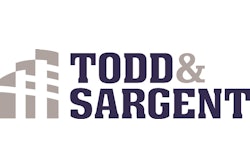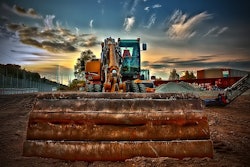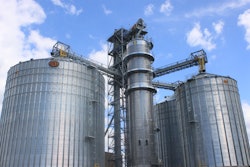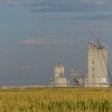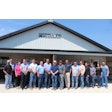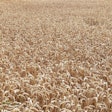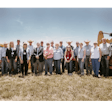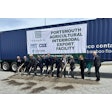
On a first-of-its-kind application of co-op equity, Aurora Cooperative and CHS, Inc. have teamed up to build a state-of-the-art high-speed shuttle loader that promises to benefit all parties involved.
Based on its long history of transactions with CHS, including selling grain and buying inputs, Aurora Cooperative had built up significant equity as part of the co-op structure.
Recognizing that the equity is in place to help develop new services for co-op members, Aurora Cooperative president George Hohwieler posed the idea of a new shuttle loader facility to Lynden Johnson, executive vice president of CHS Country Operations.
Both agreed this could be an asset. The two cooperatives formed an independent entity, Superior East LLC, as a 50/50 joint venture. The LLC leases the facility to Aurora Cooperative, which has full responsibility for management and operation.
Adding volume for BNSF
From the outset, the intent was to build a simple, high-capacity facility designed to take grain in by truck and move it out by shuttle train safely, quickly and efficiently.
- Aurora Cooperative has 17 grain elevators across south-central Nebraska and one in Republic, KS. The five elevators that comprise Aurora’s Highway 8 corridor just north of the Kansas state line, and including Republic, KS, are all older, none with the capacity to load shuttle trains.
Aurora Co-op selected its Superior, NE, location for this facility. It has three other Nebraskan shuttle loader facilities in Sedan and Grand Island, both served by the Union Pacific, and one in Aurora, served by the BNSF.
“Our Superior facility is in a trade area where BNSF lacked volume. It made perfect sense for us to work very closely with BNSF to put the shuttle loader here,” explains Chad Carlson, vice president, grain, for Aurora Cooperative.
Aurora initially explored expanding its existing in-town location in Superior, but several factors, including a creek on the property and managing higher truck traffic, prompted them to stake out property on the eastern outskirts of town.
There, Superior East LLC, at Aurora and CHS’s direction, began construction of the $28 million facility in May 2013. Todd & Sargent served as the general contractor.
An ag bio multiplex
Features include a 120-car loop track, 1.25 million bushels of permanent storage in 12 bins, 3.3 million bushels of ground-pile storage, and a 10,000-ton liquid fertilizer tank to serve the cooperative’s agronomy division.
“We refer to our locations as ‘bio multiplexes,’” Carlson says. “We can serve our members’ needs for fertilizer and handling grain. With the loop track in place, it was an easy decision to have the liquid fertilizer available to receive shuttles of fertilizer.”
Another easy decision was adding 1,000 feet of track to the initial loop design to handle 120-car shuttles. “Shuttles started at 90 to 100 cars, now they’re 110. We built for the future, knowing that shuttles could easily go to 120 cars,” Carlson explains.
Built for the future
In operation, the new facility is meeting the expectations. Trucks enter across a Rice Lake scale. The driver scans his card across the reader and selects the proper account for the load as a grain sample is pulled with a Gamet probe. The truck moves ahead to one of two 1,200-bushel receiving pits. After dumping, the truck moves ahead to an outbound scale, is weighed, then exits.
It’s a quick process. Connor Hiebner says that when everything was going full bore at harvest, trucks went from scale to scale in under four minutes.
Hiebner is the terminal manager for the facility. A recent graduate from University of Nebraska – Lincoln in mechanical systems management, he connected with Aurora Cooperative as an intern. When he started as a full-time employee in May 2014, he had the benefit of being on-site during the facility’s construction and start-up.
The two dump pits each have 20,000-bushel/hour reclaim conveyors that can feed into any of three legs: two 30,000-bushel/hour legs and a 20,000-bushel/hour leg that also removes grain from the 7,000-bushel/hour dryer.
As trucks are unloaded, a Mac Process dust collection system minimizes any dust escapes; the dust is consolidated and reintroduced.
Inbound grain can be directed to any location including the facility’s outdoor storage. Still in the final stages of completion until late April, the outdoor storage receives grain from an overhead drag that empties through a central tower. The tower, fully perforated, also draws air through the pile for ventilation.
A reclaim drag is flush with the cement floor and runs from the tower to the grain legs. The pile can be filled and emptied using these overhead and subfloor drags exclusively. The only extra equipment needed is a wheel loader to push the last bit of grain in to the subfloor drag.
Grain movement is monitored and controlled using Comco automation systems. From Hiebner’s office, and from several computer terminals around the property, grain flow and equipment status can be confirmed at a glance.
Hiebner says the state-of-the art technology makes all processes run more smoothly and safely.
“For example, our legs have alignment warnings for the tail and the head. There are plug alarms, run/fail alarms, speed trip alarms to warn if the top or bottom drums are running at different speeds, and alarms if a belt is rubbing the side.
“The safety provided by these systems is a big deal. Moving as much grain as we do, we don’t want things to go wrong,” Hiebner says.
Sensors on critical systems have the ability to initiate automatic sequenced shutdowns. “Generally, this starts with the pit gate closing to stop the flow of grain; then it goes through a clean-out process prior to shutdown,” Hiebner says. The system also performs this automated shutdown when commanded at closing time.
Train load-out
All inbound grain at the Superior facility is destined for train load-out. There’s an option for truck load-out if serving local markets makes sense, but the focus is on getting shuttles in, loaded and out.
The BNSF pulls the 110-car shuttle and its typically three locomotives into the Superior loop. The BNSF crew departs, and the Aurora employees assume control of the train.
The loading process includes an operator in the locomotive and an operator working the loader spout joystick controls, who radios commands to the locomotive operator.
As a railcar passes the card reader, it signals the elevator’s bulk weigher system as to the exact amount of weight that particular car requires. The bulk weigher weighs and releases the grain into the car, with the amount confirmed by the automated system for each car’s manifest.
Two workers wearing fall restraint gear work on top of the railcars, one opening hatches, the other closing hatches.
An employee stationed next to the loader spout operator monitors the loading progress via the computer screen. And, in the same office, two samplers pull and tag samples of grain that is continually drawn from the stream. One sampler is an Aurora employee who constantly checks the samples for grade quality and condition; if they detect any grain going off-grade they are able to make blend adjustments on the go. The second sampler is a representative from an independent grain inspection service who documents a sample from each car.
The shuttle loader facility is enclosed to protect workers from the elements and for more efficient dust management. Dust is recycled back into the grain being loaded to assure accurate weights.
When the train is loaded, the Aurora team hands it over to the BNSF crew, who drive it off the property to its destination.
Carlson says the efficiencies brought forth by the circular track are tremendous. “The train stays intact,” he says. “There’s no decoupling and coupling cars, no shuttling cars, no building air.”
He says BNSF recognized the value this level of efficiency presented to them, and were a very willing participant in making it all come together. While Aurora Cooperative owns the loop track on their property, BNSF handled the improvements on their connecting track. And, the railroad worked with Aurora Cooperative for the extensive training and agreements needed for Aurora personnel to operate the train on its property.
“A crew can spot a train here and come back and pick it up in 10 hours. It can hit the California market and come back, doing those turns just as fast as possible,” says Carlson. “This facility makes the railroad much more efficient.”
New markets, new options
Carlson says having this large, new high-capacity facility greatly benefits the farmer/owners of the Aurora Cooperative. Obvious benefits include lower cost transportation costs to export market ports and large inland consumers such as Texas feedlots.
Beyond that, this new facility provides new options for the co-op’s other grain elevators.
“Before, we were running a lot of volume through those older houses, and it was difficult. Now, here, we have huge capacity to move corn and soybeans, and we can stage various segregated and identity-preserved grains at our smaller assets, as needed,” Carlson explains. “This provides a redeployment of how we use our facilities.”
Carlson and Hiebner both say their farmer/owners are impressed with the speed, the technology and the simplicity of the new Superior location.
“It’s a state-of-the art facility that this part of southern Nebraska and northern Kansas has never seen,” Carlson says. “It’s built this way in part because our farmer/owners are working the exact same way. They are using the latest in technology, size and speed, and it’s important for us to be in step with that. We’re very optimistic about agriculture. The reality is we are feeding the world. To have the facilities, the people and means to move this food supply to the rest of the world is of upmost importance.”


